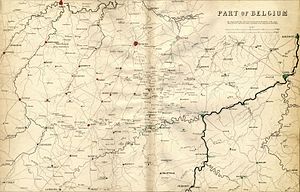| Napoleonic Wars | |||||||
|---|---|---|---|---|---|---|---|
| Part of The Waterloo campaign | |||||||
 A portion of Belgium with some places marked in colour to indicate the initial deployments of the armies just before the commencement of hostilities on 15 June 1815: red Anglo-allied, green Prussian, blue French | |||||||
| |||||||
| Belligerents | |||||||
|
|
| ||||||
| Commanders and leaders | |||||||
| Napoleon, Marshal Grouchy | Prince Blücher | ||||||
| Strength | |||||||
| French Army order of battle | Prussian Army order of battle | ||||||
On 16 June 1815, the French defeated the Prussians at the Battle of Ligny. The Prussians successfully disengaged and withdrew north to Wavre where they regrouped, and later advanced westward with three corps to attack the right flank of the French army at the Battle of Waterloo. The French were slow to exploit Ligny; Napoleon wasted the morning of 17 June with a late breakfast and touring the previous day's battlefield before organising a pursuit of the two Coalition armies. Napoleon and Marshal Michel Ney took the French reserves to pursue the Duke of Wellington's Anglo-allied army. Marshal Emmanuel de Grouchy was ordered to pursue and harry the Prussians and prevent them from regrouping.
Napoleon and Grouchy assumed that the Prussians were retreating towards Namur and Liège to take up a line on the river Meuse. On 17 June, Grouchy sent the bulk of his cavalry ranging in that direction as far as Perwez. From a 22:00 despatch to Napoleon, Grouchy still thought the Prussians were retreating north-east although by then he knew that two Prussian corps were heading north towards Wavre. From another despatch four hours later, Grouchy intended to advance to either Corbais or Wavre. However, at the end of 17 June his detachment was behind the Prussians, on the far side of the Dyle; Grouchy could neither prevent the Prussians at Wavre from moving to Waterloo, nor regroup with Napoleon on 18 June at Waterloo.
On the morning of 18 June, the remaining Prussians crossed the Dyle in and around Wavre and headed westwards towards Waterloo. Grouchy was at Sart-lez-Walhain when at about 11:30 he and his staff heard cannonades from the Battle of Waterloo, 23 kilometres (14 mi) to the northwest; a local notary gave them an accurate location of the source of the sound. There were no direct roads from Grouchy to the battle, but there was a road to Wavre, 13 kilometres (8.1 mi) away to the north-northwest. Grouchy moved on Wavre, arriving at 16:00. At the Battle of Wavre, the French defeated the Prussian rearguard, the Prussian III Corps commanded by Johann von Thielemann, which had been about to leave for Waterloo.
The Prussian advance to Waterloo was impeded by swollen streams, which turned their valleys into muddy swamps, in particular the small river Lasne close to Saint-Lambert. Napoleon neglected to screen his right flank and failed to detect the Prussian's approach. At around 17:00 on 18 June, the Prussian vanguard started to arrive at Waterloo in strength from the Wood of Paris; shortly after they were attacking the right flank of Napoleon's army.
© MMXXIII Rich X Search. We shall prevail. All rights reserved. Rich X Search
